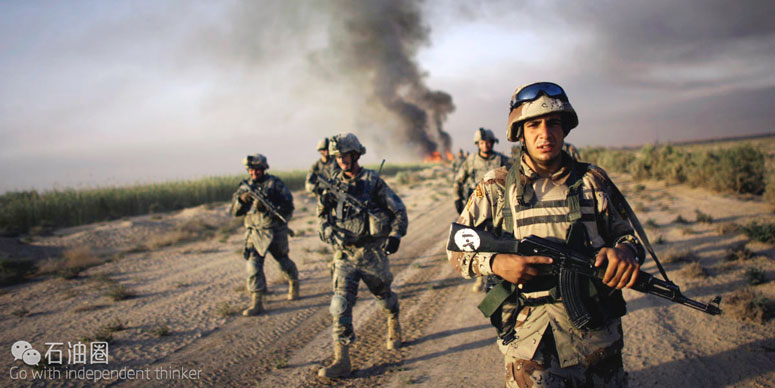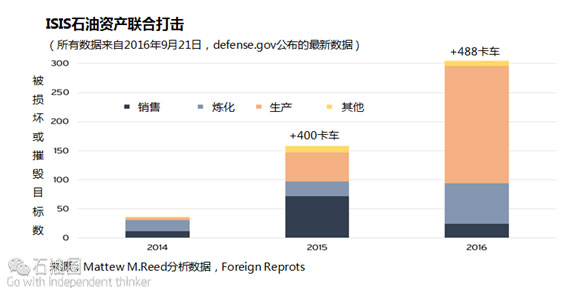A year ago I complained that ISIS “doesn’t publish data or hold conference calls with shareholders.” This is still the case, of course, but important details have come to light in the last year which improve our understanding of the group’s illicit oil trade. What follows are the most interesting revelations I’ve come across since I wrote my two–part primer for The Fuse last October. September 24 marks two years since the first strikes against ISIS oil targets in 2014.
Let’s start with how ISIS prices oil: I’ve maintained that ISIS oil was immune to international market forces because the group deals with a captive market. “There’s no proof ISIS pins its price to anything other than what locals will pay for it,” I wrote last year. Now I’m less sure.
ISIS and international prices seem to have fallen in tandem over the same period. ISIS sold its highest quality grades in November 2014 for $50-70/barrel when Brent crude, the international benchmark, averaged $80/barrel. In 2015, Brent averaged $50/barrel overall but dropped as low as $35/barrel in December. The price range for ISIS oil also tumbled into the $25-45/barrel range last year according to a field-by-field breakdown by the Financial Times. ISIS output appears to have been resilient in 2015 and the local market could have consumed virtually all of it, which should have buoyed prices somewhat. Yet ISIS charged less for oil last year than the year before.
Oil prices aside, the cost of fuel has been a major headache for ISIS because they exercise less control over refining than they do oil production. Shortages have quadrupled fuel prices at times. Intel from the May 2015 Abu Sayyaf raid confirmed top ISIS officials faced pressure to cap trader profits on crude oil and retail prices on fuel. But it’s still unclear how closely crude prices track with fuel prices inside ISIS territory. ISIS reportedly gamed these margins to maximize profits, stockpiling goods to sell later at higher prices.
Just how involved is ISIS in daily oil operations? I assumed ISIS relied on skeleton crews of locals led by true believers who had industry experience. But there’s proof ISIS operations are run more like joint ventures with locals and even with companies based outside their territory. To secure and sell fuel, ISIS “acquired” modular refineries inside Syria without ever running them. ISIS supplied the oil and it took a cut of the product and retail profits.
Commercial scale production operations are handled more like proper joint ventures, sometimes employing foreigners who are not on ISIS payroll. According to an FT investigation, Syrian state and private companies pay worker salaries and operational expenses at gas facilities controlled by ISIS. This keeps the power grid humming inside regime strongholds, which have the power plants, and ISIS territory, which has natural gas (90 percent of Syria’s electricity is generated using natural gas).
ISIS enforcers are a fixture of the oil and gas industry nowadays, patrolling facilities, punishing workers and making sure no profits escape ISIS auditors. But ISIS isn’t in total control of operations everywhere even if it has engineers and managers of its own.
How successful has the Tidal Wave II campaign against ISIS oil been? Judging by the pace of strikes this year, 2016 looks to be the worst yet for ISIS oil—and it’s only September. Tidal Wave II is nearly a year old but it is a semi-permanent mission: As long as ISIS has oil, the campaign will not stop. This summer it went into overdrive. (Note: truck strikes are not graphed below because they would distort the chart’s scale.)
The Abu Sayyaf documents showed that ISIS earned $40-50 million a month from oil sales in late 2014/early 2015 when the group produced some 55 thousand b/d. In July, a coalition spokesman told the press that ISIS collected $30 million a month in oil sales before Tidal Wave II. As of mid-2016 he estimated that revenues were down by half to $15 million a month.
In terms of volumes, officials won’t guess how much oil ISIS actually produces. Daily production numbers must vary widely given conditions on the ground. Thus, barrel-per-day estimates are unhelpful if not misleading. In addition, the debate inside the U.S. government appears unresolved. Other departments may not agree with the Pentagon.
That said, the chart above suggests the Pentagon’s optimism is not misplaced.
Without oil, how durable is the so-called Caliphate? U.S. and others are convinced oil never represented more than half of their total revenues. ISIS imposes a range of taxes and fees on all kinds of trade. The group collects a tithe of 2.5% on all capital owned by its “citizens” and it steals supplies from farmers, some of which is surely resold. It charges customs on everything coming to or from ISIS territory (construction materials, cooking oil, livestock, appliances, etc.). The group sells war spoils as well, ranging from ancient artifacts to jewelry to flat-screen TVs.
U.S. and others are convinced oil never represented more than half of their total revenues.
ISIS continues to generate revenue in less direct ways. For example, the group taxes utilities like electricity, which in reality are provided by the Assad regime. As a bonus, joint ventures with ISIS reportedly come with the condition that the group be paid to “protect” facilities they’ve captured. ISIS charges extra to protect Christian workers.
All this is to say that the group has reliable revenue streams besides oil.


 石油圈
石油圈




